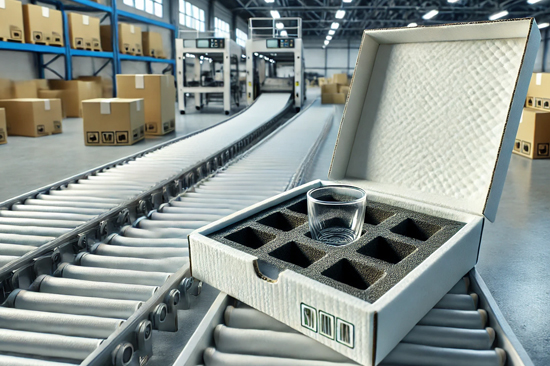Efficient and reliable packaging solutions are essential to success in logistics, e-commerce, and industrial sectors. As businesses strive to ensure their products reach customers intact, innovative foam applications have emerged as a game-changer in the shipping industry. Sterling Manufacturing, based in Houston, Texas, is at the forefront of providing custom foam packaging services that cater to a wide array of industries. This article explores the versatility and value of foam in shipping, highlighting how custom foam solutions protect, cushion, and optimize packaging.
The Versatility of Foam in Packaging
Foam is an incredibly versatile material used across various packaging applications due to its ability to absorb shocks and provide cushioning.
It can be tailored to fit the specific shape and size of a product, ensuring a snug and secure fit during transit. This customization is crucial for protecting delicate items such as electronics, medical equipment, and luxury goods from damage caused by impacts or vibrations during shipping.
Foam’s versatility extends beyond its protective qualities. It comes in different forms, such as polyurethane (PU), polyethylene (PE) and expandable polystyrene (EPS), each offering unique benefits:
- PU is known for its softness and ability to absorb shocks, making it ideal for fragile items.
- PE, on the other hand, is more rigid and moisture-resistant, suitable for products requiring extra protection against environmental factors.
- EPS is composed of small round beads that have been expanded by steam heat, making it a widely used solution for packaging dunnage, floatation, and insulation.
Protection and Cushioning: Key Benefits of Foam Packaging
One of the primary advantages of using foam in packaging is its superior protection against impacts.
Foam’s cellular structure allows it to absorb and disperse external forces, reducing the risk of damage during transit. This feature is particularly beneficial for products that are sensitive to vibrations or sudden impacts, such as computer monitors or military optics.
Moreover, foam provides excellent cushioning by evenly distributing impact forces across its surface. This prevents concentrated pressure points that could lead to breakage or deformation of the packaged item.
The ability to customize foam inserts further enhances their protective capabilities, ensuring that each product receives the precise level of cushioning it requires.
How Foam Protects and Cushions |
|
| Impact Advantage | Why it Works |
| Tailored Design | Custom foam solutions can be designed to fit specific shapes and sizes, ensuring optimal protection in vulnerable areas. |
| Enhanced shock Absorption | High-density or specialized foam materials can absorb and dissipate impact energy more effectively than generic materials. |
| Weight Optimization | By selecting the right foam type and density, custom solutions can provide adequate protection without adding excessive weight. |
| Durability and Resilience | High-quality foams can withstand repeated impacts without losing their protective properties. |
Optimizing Packaging Efficiency with Foam
Custom foam solutions not only protect products but also optimize packaging efficiency.
By using foam inserts tailored to the product’s dimensions, businesses can streamline their packing processes. This reduces the need for additional packing materials like bubble wrap or packing peanuts, leading to less waste and faster packing times.
Foam’s lightweight nature also contributes to cost savings in shipping. Being up to 90 percent air, foam reduces the overall weight of packages, which can lower shipping costs significantly. Additionally, lighter packages are easier for warehouse employees and shipping personnel to handle, further improving operational efficiency.
Environmental Protection: Foam as a Barrier
Beyond impact resistance, foam acts as a barrier against environmental elements such as moisture and temperature fluctuations.
This protective layer ensures that sensitive products remain unaffected by external conditions during transit.
For instance, PE foam’s moisture resistance makes it ideal for shipping items vulnerable to humidity or sea salt exposure.
The dangers of not protecting your packaging from environmental elements include:
- Corrosion and Deterioration: Moisture can lead to corrosion of metals, rust, and the deterioration of materials like paper, wood, and textiles.
- Mold and Mildew Growth: High humidity levels can create ideal conditions for mold and mildew growth, which can damage products and pose health risks.
- Product Performance: Extreme temperatures can affect product functionality. For example, high temperatures can cause components to warp or melt, while low temperatures can lead to cracking or reduced efficiency.
- Shelf Life and Durability: Exposure to harsh environmental conditions can shorten the shelf life of products and reduce their overall durability.
- Safety Concerns: In some cases, environmental factors can create safety hazards, such as electrical shorts or structural failures.
- Regulatory Compliance: Many industries have specific regulations regarding product packaging and storage to ensure quality and safety.
Enhancing Brand Image with Professional Presentation
Custom foam packaging not only protects products but also enhances their presentation.
“One aspect of brand building that’s not talked about enough is product packaging, in spite of the fact that it’s the first tangible impressions customers get of what your company can bring to the table,” says Agility PR Solutions.
A well-packaged product creates a positive impression on customers by demonstrating a company’s commitment to quality and attention to detail.
When customers unbox a product that arrives safely cushioned within custom foam inserts, it boosts brand perception and customer satisfaction.
Innovative Foam Applications Transforming Shipping
Innovative foam applications in shipping are transforming the industry by offering enhanced protection, customization, and sustainability. Here are some of the most innovative applications today:
- Smart Foam Materials: Smart foam materials are at the forefront of innovation, integrating sensors and responsive properties that can detect changes in environmental conditions such as temperature, humidity, or impact. These materials provide real-time feedback on the status of packaged items, ensuring optimal protection throughout the shipping process.
- IoT Integration: The integration of Internet of Things (IoT) technology within foam inserts enables tracking and monitoring capabilities. Sensors embedded in the foam can provide data on a package’s location, handling conditions, and impact history. This transparency helps ensure that packages are handled with care and allows for better logistics management.
- Foam-in-Place Systems: Foam-in-place systems offer a cost-effective and time-efficient packaging solution by creating custom protective molds around products in real-time. This technology simplifies the packaging process, reduces costs, and increases productivity by providing precise protection tailored to each product’s needs.
- Biodegradable and Eco-Friendly Foams: With a growing emphasis on sustainability, biodegradable and compostable foam materials are gaining popularity. These foams biodegrade much faster than traditional materials like expanded polystyrene, significantly reducing environmental impact.
- Advanced Material Innovations: Innovations in material composition are enhancing the performance of foam packaging such as high-performance foams that offer weight savings without compromising protection. These lightweight materials reduce fuel consumption during transportation, aligning with sustainability goals.
- Enhanced Customization through 3D Printing: The advent of 3D printing technology is revolutionizing the customization of foam inserts. This technology allows for on-demand production of highly tailored foam inserts, offering unprecedented levels of precision and customization to meet specific packaging requirements.
These innovative applications demonstrate how foam is evolving to meet the demands of modern shipping challenges.
By leveraging smart technologies, sustainable materials, and advanced manufacturing techniques, foam packaging solutions are enhancing product protection while promoting efficiency and environmental responsibility.
As the industry continues to innovate, businesses looking for cutting-edge packaging solutions should consider partnering with companies like Sterling Manufacturing. Contact Sterling today to explore how their innovative foam solutions can protect your products and optimize your shipping processes.


